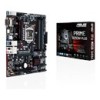Asus PRIME B250M-PLUS PRIME B250M-PLUS Users manual ENGLISH - Page 16
Audio 2.1, 4.1, 5.1 or 7.1-channel configuration
 |
View all Asus PRIME B250M-PLUS manuals
Add to My Manuals
Save this manual to your list of manuals |
Page 16 highlights
Audio 2.1, 4.1, 5.1 or 7.1-channel configuration Port Light Blue Lime Pink Orange Black Gray Headset 2.1 channel Line In Line Out Mic In - - 4.1 channel Line in Front Speaker Out Mic In - Rear Speaker Out - 5.1 channel Line in Front Speaker Out Mic in Center/Subwoofer Rear Speaker Out - 7.1 channel Line in Front Speaker Out Mic in Center/Subwoofer Rear Speaker Out Side Speaker Out 10. USB 3.0 ports (blue, Type A). These 9-pin Universal Serial Bus (USB) ports are for USB 3.0 devices. • USB 3.0 devices can only be used for data storage. • We strongly recommend that you connect USB 3.0 devices to USB 3.0 ports for faster and better performance from your USB 3.0 devices. • Due to the design of the Intel® 200 series chipset, all USB devices connected to the USB 2.0 and USB 3.0 ports are controlled by the xHCI controller. Some legacy USB devices must update their firmware for better compatibility. 11. USB 5Gb/s Type C port. This 24-pin Universal Serial Bus (USB) port is for USB (Type C) devices. 12. HDMI port. This port is for a High-Definition Multimedia Interface (HDMI) connector, and is HDCP compliant allowing playback of HD DVD, Blu-ray, and other protected content. 13. DVI-D port. This port is for any DVI-D compatible device. DVI-D can not be converted to output from RGB Signal to CRT and is not compatible with DVI-I. 14. USB 2.0 ports. These 4-pin Universal Serial Bus (USB) ports are for USB 2.0/1.1 devices. 1-7 E12098_PRIME_B250M-PLUS_UM.indb 7 ASUS PRIME B250M-PLUS 2016-11-07 17:34:22















